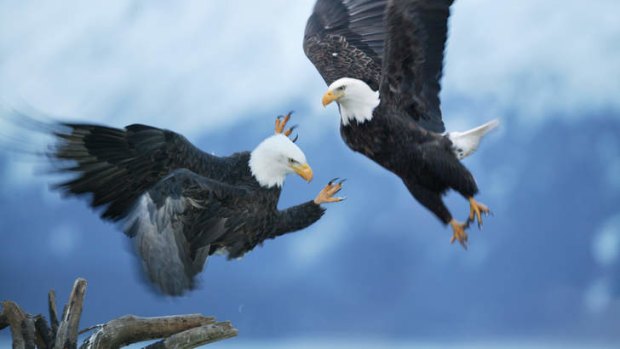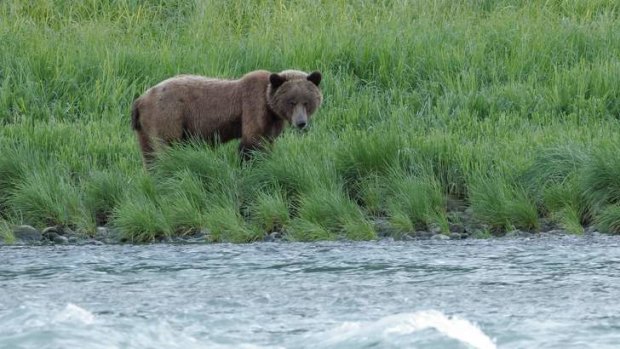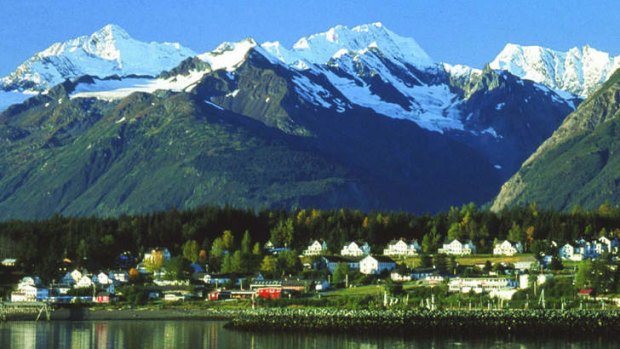
Winging it: bald eagles fight.Credit: Getty Images
Locals and a small-town location create a winning appeal, writes Lance Richardson.
A town is only as interesting as its inhabitants. Big cities can dazzle through their attractions and aura - New York, the "big apple" - but small places are all about the people who live in them.
I was reminded of this fact recently in Haines, a blink-and-you'll-miss-it idyll in Alaska's Inside Passage, just a short flight from Juneau, or a slightly longer ferry ride on the Alaska Marine Highway, or a much longer drive across two mountain ranges and a detour through northwest Canada. Haines is tucked in the Tongass National Forest, on a peninsula surrounded by dramatic fjords and mountains.

A bear in the wild.Credit: Travel Alaska
There are glaciers sliding over cliffs, dense spruce trees, and a year-round population of 350 bald eagles. The visitors' bureau has branded it "The Adventure Capital of Alaska" - probably an overstatement, though not by much: Haines offers heliskiing and heliboarding and mountain climbing and ice climbing, all of which are terrifying.
But Haines is really about the locals - 2000 or so of them - who pop up, as you wander around, with the compelling regularity of a television ensemble. For instance, there is Paul Wheeler, who founded a brewery in the abandoned set of the Disney drama White Fang ("We opened our doors on the summer solstice in 1999," he told me).
And Steve Kroschel, who lives in the woods with a menagerie of lynx, wolves, and wolverines. And Christy Tengs Fowler, a saloon owner who has crafted Dr Phil sayings into songs so unusual that a Seattle documentary filmmaker has started following her.

Haines, Alaska.Credit: Travel Alaska
"If you read our local paper, it's like Peyton Place," Tammy Piper explained in the visitor's centre, right before she revealed that her father once gave her up to Tlingit Indians. "I'm more native than some natives."
On Main Street, a stone's throw from the turquoise waters of Portage Cove, the Sheldon Museum offers collections of Tlingit artefacts and gold-rush history; it's the sort of museum you would expect to find in a town of this size and provenance.
Opposite the Sheldon Museum there is a giant hammer in front of a rickety looking shack. This is the Hammer Museum, "dedicated to the history of humanity's first tool". This is less expected.
"I've been a hammer enthusiast for 42 years," explained the owner, Dave Pahl, as I admired his extensive and lovingly arranged displays: the autopsy hammer, the modern art hammer, the Russian ship gong mallet, the pig-leg pig hammer ("Meat tenderizer or hammer art?" a plaque teases. "You decide!").
Pahl came to Haines in 1972, drawn by the challenge of self-sufficiency in the wilderness. He homesteaded with his wife out near Mosquito Lake, and spent the next 16 years in a log cabin without electricity. "Then we built a hydro-electric plant," he remarked offhandedly, as if this were nothing much.
Talking about his collection, Pahl is like a car enthusiast showing off Porsches. At one point he held up a hammer with eight claws, saying, with a grin, "This is what happens if hammers start fooling around with fertility drugs".
Haines is so small you can stumble over people like Pahl without even trying. The liquor store looks like a wild west saloon. There is a large public mural showing an eagle tearing flesh off a salmon. Every Wednesday during summer a cruise ship glides into port and disgorges tourists, who wander into an old hospital that is now a totem pole carving facility; or around Fort Seward, a former military base now largely owned by two families, the Heinmillers and Greggs.
Showing me the "ancestral house" where she grew up - blood-red bathroom, a bear skin draped across the pool table - Annette Gregg described Haines before the cruise liners and artists brought their modest gift of prosperity. "You could be a doctor and you'd end up running a hardware store," she recalled. "You did what you needed to do to survive. We're bootstraps people here."
I heard a similar sentiment expressed by Dave Olerud, founder of the American Bald Eagle Foundation, located in an improbably large building on Haines Highway.
After Haines lost its canning industry in the early 1970s, Olerud was tasked with harnessing the bald eagle population as a way of attracting visitors (and their wallets). The subsequent saga, which he unfurls with the episodic suspense of a Dickens novel, involves a travelling salesman, a bird-mad philanthropist, his feuding offspring, and a horrific accident in which a wall fell on top of Olerud and snapped his back, rendering him paraplegic. Not that this slowed him down much. Olerud now has his sights set on a school of ornithology for Haines.
I could go on: There's a public radio station (KHNS FM) with thousands of classic vinyls; gold prospectors working claims outside of town; and writers like Heather Lende, author of the aptly titled If You Lived Here, I'd Know Your Name.
One morning while driving down Mud Bay Road and fantasising about a cabin in the woods for myself, I stopped by Extreme Dreams to visit John and Sharon Svenson. Over the past 30 years, the Svensons have built a bohemian paradise where the sole focus is creating art - mosaics, woodblock prints, glass baubles. John calls the latter "afterthoughts," or cremation beads.
These morbid mementos can be made into jewellery or reserved for more creative uses. To illustrate the idea, he told me about the time his mother died; he encased her ashes and took the beads travelling around the world.
"I shot her into an active volcano," he said.
"I hid one bead inside a bite of hamburger and fed her to a lion on the Serengeti."
We were standing in a gallery with a breathtaking view of the spruce forest outside. As Svenson spoke, I started noticing other things as well: a Nazi helmet on a shelf, a glass eye on the desk, a giant whale vertebrae dangling from the ceiling. Nothing surprised me by this point; Haines with its characters is like one of those lucid dreams you never want to wake up from.
"It's unlimited, what you can do," Svenson said, glancing down at his handiwork. But he could have been talking about Alaska, too.
The writer was a guest of the Alaska Tourism Office.
TRIP NOTES
GETTING THERE
The easiest way to fly from Sydney and Melbourne to Juneau is via Honolulu. Qantas code-shares with Alaska Airlines. From Juneau, catch a small aircraft flight with Wings (wingsofalaska.com), or a ferry to Haines. See dot.state.ak.us/amhs.
STAYING THERE
Located on Officer's Row, the spacious apartments of Fort Seward Condos offer the best views in town and loads of stories tucked among the retro furniture. Rooms start at $170 a night. See fortsewardcondos.com.
SEE + DO
If you have a car, the Haines Highway starts at theferry terminal and stretches more than 240 kilometres through the Chilkat Valley into Canada. The route is so beautiful it has been declared a National Scenic Byway.
MORE INFORMATION
Sign up for the Traveller Deals newsletter
Get exclusive travel deals delivered straight to your inbox. Sign up now.